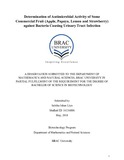| dc.contributor.advisor | Siddique, Romana | |
| dc.contributor.author | Liya, Sabiha Jahan | |
| dc.date.accessioned | 2018-07-03T09:27:49Z | |
| dc.date.available | 2018-07-03T09:27:49Z | |
| dc.date.copyright | 2018 | |
| dc.date.issued | 2018-05 | |
| dc.identifier.other | ID 14136006 | |
| dc.identifier.uri | http://hdl.handle.net/10361/10306 | |
| dc.description | This thesis is submitted in partial fulfilment of the requirements for the degree of Bachelor of Science in Biotechnology, 2018. | en_US |
| dc.description | Cataloged from PDF version of thesis. | |
| dc.description | Includes bibliographical references (page 36-39). | |
| dc.description.abstract | Urinary Tract Infection (UTI) is a worldwide phenomenon in modern times which is increasing the dependency on antibiotics for its treatment. The current study was conducted in order to find alternatives to antibiotics by investigating some commercial fruits for their antimicrobial activity. The fruits in this study includes Green Apple (Malus domestica), Papaya (Carica papaya), Lemon (Citrus limon) and Strawberry (Fragaria ananassa) which were used to prepare methanolic and ethanolic extracts through soxhlet extraction technique. The extracts were used against bacteria that causes UTI and five different strains were selected: E. coli ATCC: 15922, E. coli ATCC: 25922, Pseudomonas aeruginosa ATCC: 27853, Enterococcus faecalis ATCC: 29212 and Klebsiella pneumoniae. The fruits were bought from the local market, cut into small slices and were subjected to sun drying to reduce their moisture content. The dried fruit slices were grounded to fine powder and then run through soxhlet extractor to obtain methanolic and ethanolic extracts by using respective solvents. Antimicrobial test of the extracts were conducted by following agar well diffusion method, where ciprofloxacin was used as a positive control and distilled water was used as a negative control. Among the fruits, Apple and Papaya did not show any zone of inhibition against any of the tested bacteria. But both Lemon and Strawberry showed inhibition zone against all of the mentioned bacteria. The ethanolic extracts of Lemon and Strawberry were more potent than the methanolic extracts. Lemon ethanolic extract showed the highest zone of inhibition against Pseudomonas aeruginosa ATCC: 27853 (18.34 ± 0.58) and lowest against Klebsiella pneumoniae (16.00 ± 1.00). Strawberry ethanolic extracts were also more potent than their methanolic extracts. The highest zone of inhibition was seen against Pseudomonas aeruginosa ATCC: 27853 (16.33 ± 0.58) and the lowest one against Klebsiella pneumoniae (13.33 ± 0.58). The results of Lemon and Strawberry can be considered to be used as an antimicrobial agent in treating UTI. | en_US |
| dc.description.statementofresponsibility | Sabiha Jahan Liya | |
| dc.format.extent | 39 pages | |
| dc.language.iso | en | en_US |
| dc.publisher | BRAC Univeristy | en_US |
| dc.rights | BRAC University theses are protected by copyright. They may be viewed from this source for any purpose, but reproduction or distribution in any format is prohibited without written permission. | |
| dc.subject | Urinary infection | en_US |
| dc.subject | Scientific classification | en_US |
| dc.subject | Fragaria ananassa | en_US |
| dc.subject | Citrus limon | en_US |
| dc.subject | Carica papaya | en_US |
| dc.subject | Malus domestica | en_US |
| dc.title | Determination of antimicrobial activity of some commercial fruit (apple, papaya, lemon and strawberry) extracts against bacteria causing urinary tract infection | en_US |
| dc.type | Thesis | en_US |
| dc.contributor.department | Department of Mathematics and Natural Sciences, BRAC University | |
| dc.description.degree | B. Biotechnology | |

